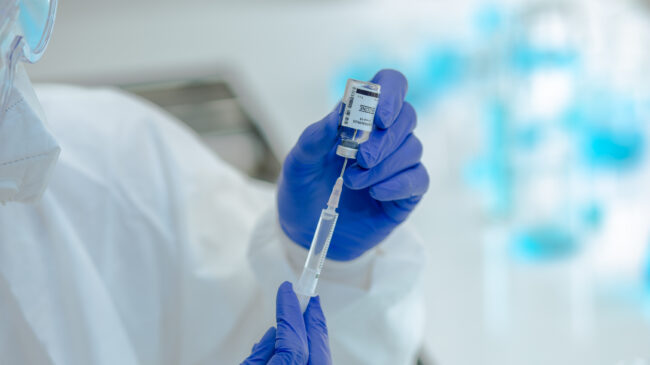The availability of a COVID-19 vaccine offers hope for eventually bringing an end to the pandemic, but problems with the distribution of the vaccine could prolong the crises and lead to unnecessary suffering. As of Jan. 5, just under five million people in the United States had received their first dose of a vaccine—which is far short of the federal government’s goal of having 20 million doses administered by the end of 2020.
To be fair, despite the problems, the U.S. has vaccinated a greater proportion of its population than most other countries thus far. Our Word in Data’s vaccination dashboard shows the U.S. slightly ahead of the United Kingdom but lagging well behind the nations of Israel and Bahrain as well as the United Arab Emirates in the total number of vaccination doses administered per 100 people in the population.
The U.S. federal government has distributed roughly 15.5 million doses to the states and territories, but 41 states have used less than 50 percent of the doses they have received. This Centers for Disease Control and Prevention (CDC) map shows the wide variation of vaccine administration rates across states. There are also concerns that states have been struggling to acquire the necessary infrastructure to prevent millions of doses of the vaccine from expiring before they can be administered.
The delays in vaccinating Americans have partially resulted from overly complicated prioritization schemes that come with uncomfortable tradeoffs. Health care workers and vulnerable populations, like the elderly and immuno-compromised, should clearly be given the highest priority, but hesitation among priority groups and a number of other issues could further delay distribution.
Ultimately, widespread vaccination is the best solution for containing the coronavirus pandemic. Rather than getting too caught up in prioritization, state and federal officials should focus on delivering vaccines as quickly as possible to those that want them. Here are a few proposals that could help achieve that goal.
Rely upon existing vaccine distribution mechanisms to the greatest extent possible.
Millions of Americans go to CVS, Walgreens, Rite-Aid, Walmart and many smaller pharmacies to get flu vaccines each year. These pharmacies have the infrastructure, staff, and logistical processes needed to rapidly immunize the general public—they just need doses of the vaccine.
Keep prioritization rules simple to reduce confusion over who is eligible.
Once health care workers and nursing home residents have been immunized, it would seemingly be easiest to base eligibility for vaccinations on age. States and counties simply have to inform distributors and the general public of the latest birth year eligible to receive shots. Pharmacies would just need to check the driver’s licenses for each customer’s birth year before administering the vaccine, as some do when selling alcoholic beverages and cigarettes. Individuals who are immuno-compromised or have other chronic vulnerabilities that would put them at increased risk of contracting a severe case COVID-19 could present a doctor’s prescription at the pharmacy to receive an early dose of the vaccines.
Avoid wasting doses of the vaccine.
Distributors in possession of doses that are within 24 hours of expiring should be free to administer the vaccines to anyone—regardless of eligibility since a wasted, expired dose of the vaccine is worse than vaccinating an individual with less need. States should not, for example, impose criminal penalties on health care providers or vaccine recipients who ignore prioritization schemes as New York Gov. Andrew Cuomo has. His distribution rules impose a $100,000 fine on any hospital that does not distribute delivered vaccines within seven days. But should the health care provider vaccinate a patient outside of the state’s distribution plan, they could receive a $1 million fine. “Damned if you let your vaccines expire, damned if you don’t let your vaccines expire—by using them on anyone outside of the approved hierarchy,” as Reason.com’s Billy Binion put it.
Extend “right-to-try” laws to allow anyone to receive a vaccine approved in other countries.
Currently, only the Pfizer/BioNTech and Moderna vaccines are approved for emergency use in the United States. But the Oxford AstraZeneca vaccine has been approved in the United Kingdom and India. Other vaccines that have been approved for emergency, limited, or general use in at least one large country include Sputnik V, EpiVacCorona, Convidecia, and BBIBP-CorV. Right-to-try laws currently allow terminally ill patients to seek investigational treatments. Since vaccines aren’t readily available here, high-risk patients and others should be able to seek out vaccines approved elsewhere.
Permit individuals to purchase vaccine doses that have not been allocated by Operation Warp Speed.
The Serum Institute of India, the world’s largest vaccine manufacturer, has announced its intention to sell a portion of the doses it produces on the open market later this year. Americans should be allowed to buy some of these doses if they would prefer to be vaccinated before government-controlled supplies of the COVID-19 vaccine are widely available.
Relax patent protections on any approved vaccine that was developed with public funds.
Allowing other vaccine manufacturers to produce approved COVID-19 vaccines would add to available supplies. While patent owners should be compensated for their intellectual property—perhaps on a per-dose basis—they should not be able to prevent other manufacturers from adding to the vaccine supply. This proposal relies on the case that Achal Prabhala, Arjun Jayadev and Dean Baker made in a Dec. 7 New York Times op-ed but stops short of suspending intellectual property rights as the authors recommend.
Do not withhold vaccine supplies to ensure second dose availability to those who have already received their first shot.
As Reason’s Ronald Bailey noted last month, preliminary research suggests that the first dose of the Pfizer/BioNTech vaccine is 82 percent effective—well above the 50 percent threshold the U.S. Food and Drug Administration (FDA) set for vaccine approvals. Also, as vaccine production ramps up, it will be possible to allocate second doses from new supplies rather than keeping existing supplies in inventory.
Conclusion
Rather than relying too heavily on central planning and top-down approaches, these steps could help ensure that COVID-19 vaccines are distributed rapidly and with minimal waste, just as decentralized markets do with a wide variety of products, including flu vaccines. The sooner we achieve widespread immunization, the more lives will be saved, the faster society can fully reopen, and the more suffering can be avoided.


